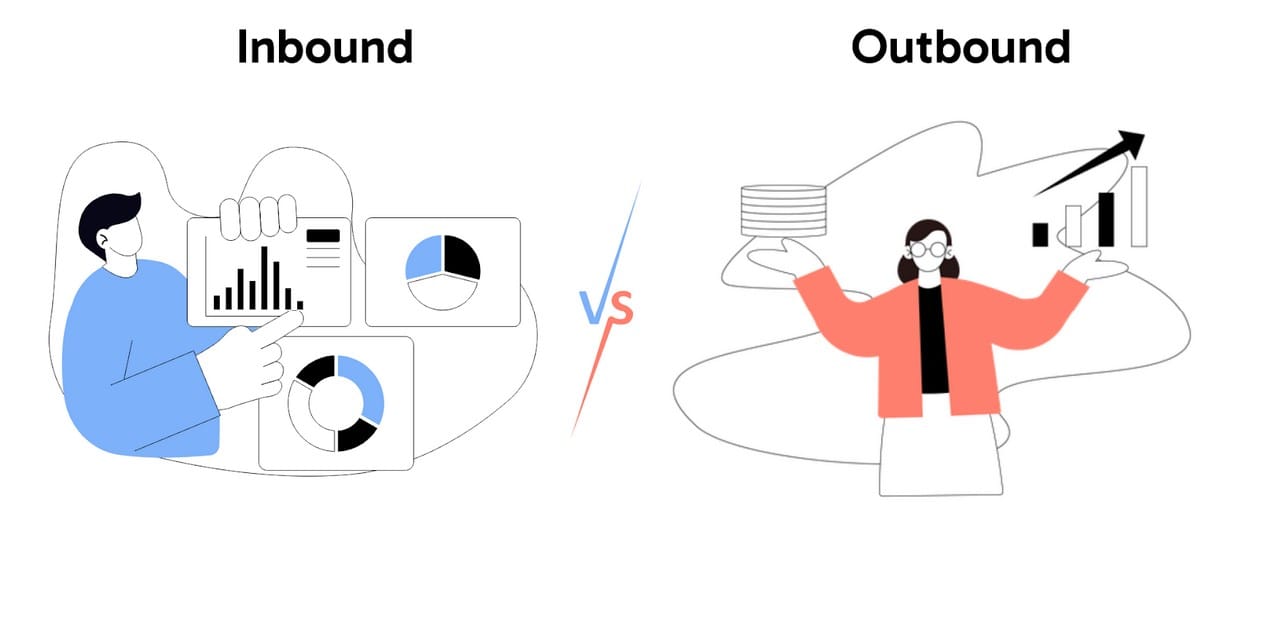Inbound vs. Outbound Sales Strategies: What’s the Difference?
Discover the difference between inbound and outbound sales strategies. Learn how each approach works and find out which one suits your business best.

Confused about choosing your sales strategy? Finding the proper balance between inbound and outbound strategies is crucial to success in sales. Inbound sales focus on attracting prospects through valuable content and nurturing leads who have shown interest in your product or service.
On the other hand, outbound sales rely on direct outreach—cold emailing, calls, and targeted ads—to generate interest among prospects who might not be familiar with your brand. Each inbound and outbound sales strategy has pros and cons. This blog will explore the core contrasts between these strategies, their strengths, and how to combine them for maximum impact on sales success.
Core Differences in Inbound vs. Outbound Sales Strategy
The core difference between inbound and outbound sales strategies lies in how leads are acquired and how prospects engage with your brand.
Inbound Sales vs. Outbound Sales: Understanding the Differences
Both inbound and outbound sales strategies impact how leads progress through the sales funnel, shaping the customer journey in different ways. Let's explore the key strategies for each approach and their respective strengths and challenges.
Inbound Sales Strategy: How It Works
An inbound sales strategy focuses on attracting, engaging, and converting potential customers by providing valuable content that addresses their needs. Here’s how it works:
- Attract:The first step is creating valuable content such as blog posts, videos, and social media updates to draw in prospects. This content should solve problems or answer questions your target audience has, aligning with their pain points and interests.
- Engage:Once you’ve attracted prospects, engage them through personalized communication, such as lead magnets, landing pages, and email campaigns. This phase aims to build trust and deepen the relationship with prospects by offering more detailed resources, like case studies or product demos.
- Convert:In the conversion phase, prospects take action, such as signing up for a trial, scheduling a demo, or making a purchase. Sales teams usually get involved at this stage to offer tailored solutions and follow up with relevant offers that push prospects toward becoming customers.
- Delight:After converting a lead into a customer, the focus shifts to delighting them with continued value and exceptional service. Satisfied customers are more likely to become repeat buyers and brand advocates, helping to generate new leads and contribute to ongoing business growth.
Inbound sales thrives on building trust, delivering value at every stage, and nurturing long-term relationships that support sustainable growth.
Here are some pros and cons of inbound marketing strategies:
Outbound Sales Strategy: How It Works
An outbound sales strategy involves proactively reaching out to potential customers to generate leads and drive sales. Here's a concise breakdown of how it works:
- Targeting and Prospecting:Identify your Ideal Customer Profile (ICP) and use tools like CRMs and lead generation software to gather lists of potential leads.
- Outreach:Initiate personalized contact through cold calls, emails, or social media to introduce your product and gauge the prospect’s interest and need.
Tools like Alisha by Floworks can help automate personalized follow-ups, so your outreach feels more tailored and consistent.
- Engagement and Qualification:Engage prospects to qualify them by understanding their pain points, budget, and decision-making process to ensure they’re a good fit for your offering.
- Pitch and Follow-up:Present your solution, address objections, and continue follow-ups with value-based content to keep the conversation moving forward.
Using automation tools like Alisha ensures that no lead is forgotten and makes the follow-up process smooth and efficient, increasing your chances of closing deals.
- Closing:Finalize the deal by negotiating terms, addressing concerns, and guiding the prospect through the purchase process.
- Post-Sale Relationship:Maintain relationships for future upselling, cross-selling, and generating referrals to feed new outbound sales efforts.
Here are some pros and cons of outbound sales techniques:
To determine whether outbound sales is the right fit for your business, it’s important to evaluate certain key indicators. Here are six signs that can help you decide if outbound sales is the right approach for your team.
6 Signs Outbound Sales is the Right Approach for Your Team
Outbound sales isn't the best fit for every business, but there are key indicators that can help you determine if this strategy will work well for your team. If you identify with these signs, it may be time to invest in outbound sales to boost your pipeline and grow your revenue.
- Clear Ideal Customer Profile (ICP): If you have a well-defined ICP, outbound sales enables targeted outreach to the right prospects. This increases the likelihood of engaging with high-quality leads.
- Long or Complex Sales Cycle: Outbound sales helps manage longer or complex sales cycles by allowing direct interaction with prospects. This ensures your team can actively guide them through each stage of the buying process.
- Expanding into New Markets: Outbound sales is ideal when entering new markets or verticals, allowing you to quickly build awareness. You can directly target key prospects and gain traction faster than waiting for inbound leads.
- Resources for a Dedicated Sales Team: If you have the resources to build or expand a sales team, outbound sales can be effectively executed. A focused team ensures consistent and strategic outreach, driving better results.
- Need for Quick Pipeline Growth: Outbound sales is perfect for rapidly filling your pipeline with prospects. It provides a proactive approach to quickly generate leads and drive immediate revenue growth.
- Offering High-Cost, Enterprise-Level Solutions: For businesses with expensive solutions targeting enterprise clients, outbound sales allow for direct engagement with decision-makers who have the budget and need for your offerings.
Picking the Right Tool for Outbound Sales
Choosing the right tool is crucial for scaling and optimizing your outbound sales efforts. Floworks’ AI-powered platform, Alisha, automates the entire outbound sales workflow, from lead research and sequencing to objection handling and follow-ups. This streamlining boosts both efficiency and effectiveness, ensuring that your sales team can focus on what matters most—closing deals.
Key Features of Alisha:
- Lead Research & Generation: Alisha identifies leads matching your ideal customer profile by accessing over 275 million contacts and 73 million companies, ensuring a steady stream of high-quality prospects.
- Hyper-Personalization: It crafts tailored emails for each prospect, driving higher engagement and response rates.
- Omni-Channel Outreach: Alisha handles outreach across both email and LinkedIn, maximizing touchpoints and coverage with potential leads.
- Automated Scheduling: The platform simplifies meeting coordination by proposing multiple time slots and understanding email tones, making the scheduling process effortless.
Conclusion
When selecting your sales strategy, consider your business needs, goals, and target audience. Inbound sales are ideal for nurturing long-term relationships with prospects already familiar with your brand, while outbound sales take a more proactive approach to generate immediate leads and results.
Floworks’ Alisha simplifies outbound sales by automating key tasks like personalized outreach and follow-ups. By integrating inbound data into your outbound strategy, Alisha ensures your team connects with the right prospects—consistently and efficiently.
Ready to enhance your sales strategy? Book a demo today and discover how Floworks can transform your outbound sales process.
FAQs
1. What is an example of inbound and outbound sales?
Inbound sales examples include customers finding your company through blog posts or social media campaigns and contacting you. Outbound sales examples involve proactive strategies like cold calling or emailing potential customers directly.
2. What is the difference between a sales process and an inbound sales strategy?
A sales process is a set of repeatable steps done by the sales teams to convert a lead into a customer, covering all sales approaches. An inbound sales strategy focuses explicitly on attracting customers through content creation, SEO, and social media to initiate contact.
3. What makes inbound sales different?
Inbound sales differ by focusing on attracting customers through educational and engaging content, allowing them to initiate contact when they're interested. This method is more passive and customer-driven compared to the direct and aggressive tactics of outbound sales.
4. Is inbound sales easier than outbound?
Inbound sales can be easier than outbound in terms of lead reception since leads come pre-interested and informed, reducing resistance and enhancing the likelihood of a sale. However, consistent content creation and SEO effort are required to attract these leads.


